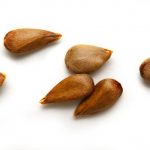Kei apple (Dovyalis caffra) is widely accepted in Southern Africa as a suitable fruit for wider cultivation. It belongs in the same genus as ketembilla (Dovyalis spp.) which is grown in Sri Lanka. They all belong to the Salicaceae family (ex. Flacourtiaceae family).
Alternative names include Kayaba, Kai apple, or Kau apple. It’s also known as Umkokola.
The fruits are small, similar to small tomatoes, tangy and almost citrusy in impact. They are a yellow-orange with small seeds.
The tree itself is small at 6 metres in height and grows throughout southern Africa but is amenable to growth in other temperate climates. It prefers bush, dry areas, edges of forest and lightly wooded grass lands. The flowers are without petals and so has little horticultural value in terms of attractiveness other than the type of fruit it produces. It can be grown in low frost areas and is tolerant of salt but especially drought which makes it ideal as a low woodland plant in sub-arid regions. It could be grown successfully in the southern half of the UK, below Birmingham for example. Our seeds have sprouted and show suitability for development in the greenhouse before planting outside in a sheltered part of the garden. A female plant is needed so it will be awhile before we fully understand the biological sex of the tree. Any fruit is supposed to appear four years or more after seedsprouting.
Uses
Mainly confectionary including jams and sauces. Plenty of sugar is needed to offset the acidity of the fruits although this does not imply that it makes a poor food product. The juice would be ideal in tropical mixes.
The tree is treated as as traditional and cultural food plant.
Components
The kei apple juice has been assessed for its antioxidant and vitamin C possessing properties. Kei apple juice had significantly high total polyphenolic concentrations (1013 mg gallic acid equivalent/L), and solid phase (C18) fractionation identified the majority of these polyphenols to be phenolic acids (Loots et al., 2006). The vitamin C content was 660 mg/L which makes it suitable for thermal processing given that vitamin C losses are high with heat processing. Gas chromatography−mass spectrometry analyses showed caffeic acid as the most abundant polyphenol present (128.7 mg/L) in the Kei-apple juice; it contributed to 63% of the total antioxidant capacity of all of the individual compounds identified. Other polyphenols included p-coumaric acid, p-hydroxyphenylacetic acid, and protocatechuic acid
References
Loots, D. T., van der Westhuizen, F. H., & Jerling, J. (2006). Polyphenol composition and antioxidant activity of Kei-apple (Dovyalis caffra) juice. Journal of Agricultural and Food Chemistry, 54(4), pp. 1271-1276

Leave a Reply